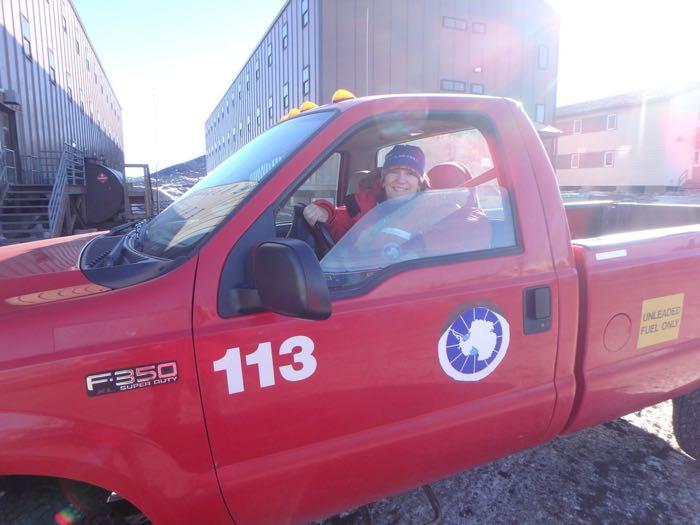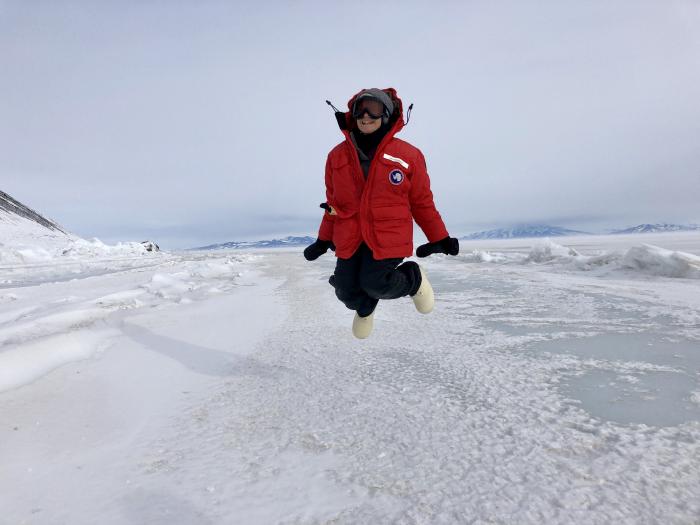Blowing snow crosses ice
Fog hovering above white ocean
Entranced by harsh beauty
 A view of Ross Island from across the sea ice near McMurdo Station, Antarctica
A view of Ross Island from across the sea ice near McMurdo Station, Antarctica
Welcome to poetry Friday! I encourage you to sit outside for a moment and write a few lines. I chose to write haiku, a Japanese style of poetry often written in 5/7/5 syllables with a focus on images of nature. If you feel like it share your poem below.
I woke up this morning thinking about ice again. I love the way it looks, this sea of white with mysteries underneath. Yesterday as I stepped on the ice, walked on it, kneeled on it, and even tasted it I felt very connected to this ice. I wish I could bring you here with me so we could share this unique experience together.
 Amy Osborne tasting sea ice just off of Ross Island near McMurdo Station, Antarctica. There's still some salt in this sea ice! Photo by Denise Hardoy
Amy Osborne tasting sea ice just off of Ross Island near McMurdo Station, Antarctica. There's still some salt in this sea ice! Photo by Denise Hardoy
Ice and cold have been helpful to humans over time. It keeps our food fresh, our drinks cold, and even helps us when we are injured.
You might be asking yourself, how can ice in the sea that is thousands of miles away help me? Take a moment and think, how do you think ice at the poles impacts you?
Here are a couple ways that the ice at the poles affects YOU:
ICE AND CLIMATE
Ice on our planet is extremely important in helping maintain the temperature and climate to which we are accustomed and adapted to live.
Ice keeps our planet at a livable temperature for you, for me, and for the animals and plants, including those we eat, that call the land and the ocean home.
Because it's white, ice reflects solar energy, also known as solar radiation, back into space rather than absorbing it. This means ice has a high albedo. Albedo means a surface's ability to reflect solar energy back into space. The higher the albedo the more energy that is reflected and not absorbed.
When sun's energy is absorbed it results in an increase in temperature. Think about going outside on a hot day. If you are wearing a white shirt, that can reflect the sun's energy, you will probably stay cooler than if you are wearing a dark colored shirt that will absorb the sun's energy. Surfaces are also this way. Darker pavement is usually hotter than lighter colored pavement because the darker pavement absorb's more of the sun's energy and the lighter pavement has a higher albedo meaning it reflects the sun's energy.
 Amy Osborne's drawn diagram showing what albedo is and how it affects the absorption of the sun's energy.
Amy Osborne's drawn diagram showing what albedo is and how it affects the absorption of the sun's energy.
As ice is lost and the darker ocean or land is exposed, which will absorb more of the sun's energy, then temperatures rise. This increase in temperature happens globally not just at the poles. As temperatures rise, less ice will form, exposing more of the darker ocean and land and even more of the sun's energy is absorbed and temperatures will continue to rise! Whew what a vicious cycle that one is!
2019 was a remarkable year as far as sea ice in Antarctica. Generally, sea ice in Antarctica has been increasing, unlike the Arctic where sea ice is decreasing. That said, according to the National Oceanic and Atmospheric Administration (NOAA), while Antarctica didn't reach a record low in sea ice, it did set a record for the lowest sea ice extent for February 2019. Sea ice extent means areas with at least 15% sea ice. Overall, sea ice around the globe is decreasing.
 From climate.gov:A graph showing overall trends in polar sea ice from 1979 to 2013 as measured by satellites. The Arctic, on the top line, is decreasing. The Antarctic, is increasing, and the third line shows the global total is decreasing. At the bottom there is another visual showing the overall trend of decreasing ice month to month year to year. Graphs by Josh Stevens, NASA Earth Observatory. Courtesy of NASA
From climate.gov:A graph showing overall trends in polar sea ice from 1979 to 2013 as measured by satellites. The Arctic, on the top line, is decreasing. The Antarctic, is increasing, and the third line shows the global total is decreasing. At the bottom there is another visual showing the overall trend of decreasing ice month to month year to year. Graphs by Josh Stevens, NASA Earth Observatory. Courtesy of NASA
At McMurdo Station the formation of the sea ice is an integral part of studying the animals that live on and under the ice. From the Weddell seals, which I mentioned a couple of days ago, to the incredible project I'm a part of studying sea spiders and nudibranchs, these researchers depend on the annual formation of the sea ice to do their work.
 Dr. Art Woods (left) and Dr. Amy Moran return from sea spider collection. Turtle Rock, Antarctica. Photo by Timothy R. Dwyer (PolarTREC 2016), Courtesy of ARCUS
Dr. Art Woods (left) and Dr. Amy Moran return from sea spider collection. Turtle Rock, Antarctica. Photo by Timothy R. Dwyer (PolarTREC 2016), Courtesy of ARCUS
ICE AND OCEAN CURRENTS
Sea ice affects the movement of ocean water. When sea ice forms, the salt doesn't freeze with it. Instead, the salt trickles down and is pushed into the cold water just below the ice. As the salt in the water just below the ice increases, the density of that water also increases. This means this dense salty water now sinks and moves towards the equator as it is replaced by warmer water traveling from the equator. As I mentioned in a previous post, this movement of ocean water is part of the global ocean conveyor belt, which is another important part of maintaining the current climate in If the amount of sea ice changes then this circulation of ocean water will also change. This, in turn, will also affect the climate of the globe.
How do you think the impact of this change in ocean circulation might affect the animals that call the ocean home? The research team I'm a part of is focused on studying changes in ocean temperatures on the development of marine ectotherms and I'm excited to say that tomorrow I'll be heading out on the ice with the divers! I won't actually be diving but I will be there supporting them.
 Graham Lobert and Aaron Toh, both part of the research team, load survival bags on top of the Pisten Bully. We will need these in case we run into trouble traveling across the ice tomorrow.
Graham Lobert and Aaron Toh, both part of the research team, load survival bags on top of the Pisten Bully. We will need these in case we run into trouble traveling across the ice tomorrow.
 Graham Lobert, a member of the research team, finishes strapping down the survival bags. These bags include a tent, a bivy sack, a stove, food, fuel, a cooking pot, a book, a deck of cards.
Graham Lobert, a member of the research team, finishes strapping down the survival bags. These bags include a tent, a bivy sack, a stove, food, fuel, a cooking pot, a book, a deck of cards.
THE FINAL TRAININGS
Today was my final day of trainings. I learned about riding and repairing snow machines. I passed a light truck driving test. (NEVER PUT ON THE PARKING BREAK IN A COLD COLD PLACE! Instead we use hydraulic breaks.) My final training was a GPS course so I know how to find my way around.
 Denise Hardoy and Amy Osborne learn the basics during snowmobile training. Photo by Katherine Ponganis
Denise Hardoy and Amy Osborne learn the basics during snowmobile training. Photo by Katherine Ponganis
 Tony Buchanan teaches us how to fix the snowmobile if it's not running.
Tony Buchanan teaches us how to fix the snowmobile if it's not running.
 Amy Osborne taking her light vehicle driving training. Never ever ever put on the parking brake. Photo by Graham Lobert.
Amy Osborne taking her light vehicle driving training. Never ever ever put on the parking brake. Photo by Graham Lobert.
 Learning to use a gps system to navigate through McMurdo. We may need this on the ice.
Learning to use a gps system to navigate through McMurdo. We may need this on the ice.
Well, I better get some sleep! I need to be ready to go and at the dive lockers with my lunch and my Extreme Cold Weather gear at 8am. I'm so excited to finally be joining the research team on the ice!
 Amy Osborne, excited to join the dive team tomorrow, jumping on the sea ice near Ross Island. Photo taken by Dave Meyer
Amy Osborne, excited to join the dive team tomorrow, jumping on the sea ice near Ross Island. Photo taken by Dave Meyer

Comments
Add new comment